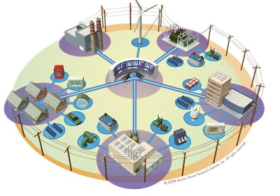A smart grid is a form of electricity network using digital technology. The idea of two-way communications from suppliers to consumers to control appliances is not new, and systems have been implemented using analog technology for many years. The growth of an extensive digital communication network for the internet has made it practical to consider a more sophisticated type of smart grid: smart cities.

What are smart cities?
A smart city is a city that uses data and information technologies to provide better services to citizens, track progress toward policy goals, optimise existing infrastructure. A smart city enables new business models for public and private sector service provision.
 In a smart city, all man-made systems come together and interact with one another: healthcare, public safety, transportation and mobility, energy, education and government services (public safety, street lighting, efficient waste collection or public infrastructures).
In a smart city, all man-made systems come together and interact with one another: healthcare, public safety, transportation and mobility, energy, education and government services (public safety, street lighting, efficient waste collection or public infrastructures).
Smart Infrastructure and technology
There are a few key technology enablers for a city to become smart: pervasive sensor networks throughout city, node connections through standardized low-cost communications, real-time analysis and control of city systems, and integration of isolated systems across cities (IPv6 like Internet of Things). Nowadays several companies are working in order to provide and enhance this infrastructure.
Smart cities use four different technologies in order to collect, transmit, storage and process the data. Moreover, a service delivery platform is needed.
Example: Smart Santander
Smart Santander is an European research facility for Internet of Things architectures, services and applications in the context of the smart city. It combines three projects WISEBED (tools and mechanisms for wireless sensor networks), SENSEI (interconnection of sensors) and Telefonica’s Ubiquitous Sensor Network service platform (storage and interfaces).
The first pilot experience was on June 2011 with 300 Internet of Things (IoT) devices. Phase 1 started on December in order to expand infrastructure with 2000 IoT devices. Next phase will be on December 2012 with 5000 IoT devices and last phase is expected to be on August 2013 where all the advanced features will be prepared for exploitation.




